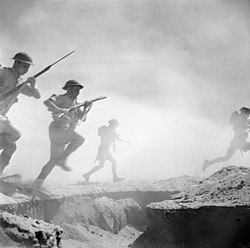Second Battle of El Alamein
| Second Battle of El Alamein | |||||||
|---|---|---|---|---|---|---|---|
| Part of the Western Desert Campaign of the Second World War | |||||||
 24 October 1942: Soldiers of the 9th Australian Infantry Division in a posed attack. (Photographer: Len Chetwyn) |
|||||||
|
|||||||
| Belligerents | |||||||
|
Axis: |
|
||||||
| Commanders and leaders | |||||||
|
|
|
||||||
| Strength | |||||||
| 116,000 men 547 tanks 192 armoured cars 770 – 900 aircraft (480 serviceable) 552 artillery pieces 496 anti-tank guns – 1,063 |
195,000 men 1,029 tanks 435 armoured cars 730 – 750 aircraft (530 serviceable) 892 – 908 artillery pieces 1,451 anti-tank guns |
||||||
| Casualties and losses | |||||||
| 36,939 to 59,000 men (9,000 killed or missing, 15,000 wounded, 35,000 prisoners) c. 500 tanks 254 guns 64 German and 20 Italian aircraft |
13,560 men (4,810 killed or missing, 8,950 wounded) 332–c. 500 tanks 111 guns 77 British and 20 American aircraft |
||||||
| The Second Battle of El Alamein | |
|
|
|
|
|
The Second Battle of El Alamein (23 October–11 November 1942) was a decisive battle of the Second World War that took place near the Egyptian railway halt of El Alamein. With the Allies victorious, it marked the watershed of the Western Desert Campaign. The First Battle of El Alamein had prevented the Axis from advancing further into Egypt. In August 1942, Lieutenant-General Sir Bernard Law Montgomery took command of the Eighth Army following the sacking of General Claude Auchinleck and the death of his replacement Lieutenant-General William Gott in a plane crash.
The British victory turned the tide in the North African Campaign and ended the Axis threat to Egypt, the Suez Canal and the Middle Eastern and Persian oil fields via North Africa. The Second Battle of El Alamein revived the morale of the Allies, being the first big success against the Axis since Operation Crusader in late 1941. The battle coincided with the Allied invasion of French North Africa in Operation Torch, which started on 8 November, as well as the Battle of Stalingrad and the Guadalcanal Campaign.
...
Wikipedia
